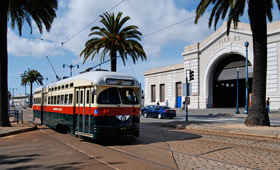This car’s exterior commemorates Birmingham, Alabama, which operated PCC streetcars from 1947 to 1953.
 Rick Laubscher photo.
Rick Laubscher photo.When streetcars were a new technology, around the turn of the 20th Century, it was common for systems to be owned by the local electric utility. Electric utilities usually had the financial capacity to handle the capital outlay involved with building streetcar lines and, of course, could supply electricity to run the car at its cost, increasing the profit of the transit lines.
So it was in Birmingham, one of only two southern cities (with Dallas) to operate the streamlined PCC car. Birmingham Electric Company (BEC) was a member of the industry group that created the PCC in the 1930s, but chose to rebuild some of its existing cars rather than buy PCCs right away. At the end of World War II BEC’s streetcar fleet was made up of 27 different types of streetcars, some dating back to 1901, and almost all worn out by heavy wartime ridership.
The company ordered 48 new Pullman-Standard PCCs, which arrived in 1947. They were used on the lines that served steel mills, which generated heavy loads at shift change times especially. Streetcar lines with lighter patronage were slated for conversion to trolley buses or motor coaches. To take advantage of the PCCs’ higher speeds, BEC ran them as expresses during rush hours on the inner end of some routes, complementing them with buses for local service on that part of the route.
Like other transit properties in the South of that era, Birmingham’s PCCs were segregated. Signs separating blacks and whites were mounted on seat backs. In December 1955, just 90 miles from Birmingham in the state capital of Montgomery, Rosa Parks famously initiated the beginning of the end of transit segregation by refusing to give up her bus seat to a white passenger. By then, however, Birmingham’s PCCs were in Toronto. A new owner, who didn’t have the incentive an electric company did to operate electric-powered transit, junked the streetcar system in 1953 and sold all the PCCs.
Originally built for
Twin City Rapid Transit Co., Minneapolis-St. Paul, MN, 1947 (as car No. 360)
Sold to
Public Service Coordinated Transport, Newark, NJ, 1953 (as car No. 21)
Acquired by Muni from
New Jersey Transit, Newark, NJ, 2004
Builder
St. Louis Car Co.
Restored by
Brookville Equipment Company, PA, 2004-2011
Seats
50
Weight
37,600 lbs.
Length
46′ 5″
Width
9′ 0″
Height
10′ 3″
Motors
4 General Electric 1220
Trucks
B-2
Brakes
Electric
